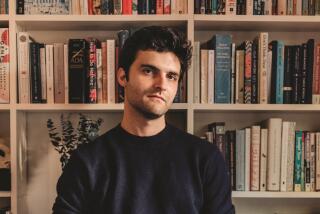Death Goes Online
- Share via
Casket shopping, cannibalism instructions and electronic graveyards have come to the Internet.
So have online obituaries, dead-pet memorials and a company that turns people into mummies.
The Grim Reaper, it seems, has scythed his way into cyberspace.
During the past year, a cortege of death-related destinations has appeared along the information superhighway, according to those who explore the electronic afterworld.
“I don’t think it’s because Americans are suddenly more morbid,” says Joel Gazis-Sax, who reviews online cemetery sites (using a four-tombstone rating system) for the World Wide Web Post-Mortem Page. “I think it’s just a natural interest that has spread to the [Internet] as [computers] grow more popular.”
Among the mortality-related outposts found during a recent excursion were a tip sheet for burials at sea (avoid locales favored by commercial fishing trawlers), recycled rumors of Paul McCartney’s death (from the 1960s) and an e-mail celebrity dead pool (best bets are “the old, the feeble, the overweight, the addicted”).
There also was the Carlos A. Howard Funeral Home, “the first full-service [mortuary] on the Internet,” which advertises the $1,192 Onyx Regal Velvet coffin, equipped with “pin-striping, adjustable bedsprings and mattress, and memorial record tube” (a time capsule inside the casket).
The most popular attractions, however, seem to be the cyber cemeteries, where the dead are laid to rest electronically.
In the Virtual Pet Cemetery, for example, Buster Brown is memorialized as “a little brown mutt . . . [who] slept in my bed at night [and] puked on my pillow at least once every three months. We will all miss him.”
At the competing Dead Pet Home Page, a canine named Nero is pictured in animal heaven “chasing cars made of smoked ham and mailmen made of salami.”
On the two-legged side of the afterlife, a Pennsylvania man’s relative bestows computerized immortality, remembering him as “an ex-cop in Philly [who] loved grandkids, the Philadelphia Phillies, fishing and me. When I cast off, I always feel another line in the water.”
And the Virtual Memorial Garden, which contains electronic epitaphs for about 1,000 humans and pets, is explored by hundreds of Internet users per day, says curator Lindsay Marshall, a British university professor who started the free service a year ago. “That’s a lot more people than you would find visiting a real cemetery,” he surmises.
Which is precisely the point, says mortician Bruce Armstrong. In today’s mobile society, where people don’t always live near their loved one’s actual grave site, “It’s important to still have a focal point to think about the person who died.”
His solution: The Cemetery Gate, which puts obituaries online for a $25 fee and offers a free list of resources on grief, including e-mail support groups.
“You can read what others have gone through or send a message about what you’ve gone through,” he says. Best of all, “It’s available 24 hours a day. If a [widow] wakes up at 3 a.m. feeling alone, there’s no [real-world] bereavement group she can go to. But she can log on.”
The death online trend also allows armchair tours to some of the world’s famous burial grounds. At the World Wide Cemetery, for instance, Internet browsers can call up photos of Paris’ Cimetiere du Pere Lachaise, final resting place of Jim Morrison, Oscar Wilde and Marcel Proust.
Other cyber sites take viewers to the Vietnam Memorial in Washington, various New Orleans graveyards, a Wolfman Jack tribute and Egypt’s Tomb of the Manicurists.
It’s also possible, in some cases, to forward messages to survivors or leave behind electronic “flowers.”
For those with more macabre leanings, there is the Dark Side of the Web, a clearinghouse of the ghastly that offers connections to such sites as the Mortuary (gruesome autopsy photos, including those of Mussolini and his mistress) and the Cannibalism page (graphic and disturbing instructions for “the preparation of humans for consumption”).
In general, however, death on the Internet seems to provide “great catharsis,” Marshall says.
A note left in the “guest book” at one digital graveyard reads: “Thank you for providing this service. It is a way for each of us to come to grips with the end of life in a way that is both intimate and public.”
And that’s just the beginning.
In parts of Canada, says undertaker Armstrong, computer users can now sign onto the Internet through cable TV hookups instead of telephone modems. That means people will soon be able to watch funeral services live--or even see the dead person in the casket--through computer video conferencing.
It will be a blessing for invalids and distant relatives, he contends. They’ll be able to access a private e-mail address rigged to allow verbal and visual interaction with family members at the funeral home.
As for online cemeteries, Marshall predicts more sophisticated memorials, complete with home movies, sound and elaborate “cyber pyramids, data sphinxes . . . [and] electronic crypts devoted to whole families.”
Still, immortality might be fleeting.
Marshall, for one, says he needs a benefactor to pay for the equipment to sustain his electronic graveyard after his own passing.
And Virtual Pet Cemetery operators Steve Hoffman and Naomi Kokubo of San Francisco are also unsure how to keep their money-losing graveyard afloat.
Says Hoffman: “We’re debating whether to put up advertisements” next to the tombs.
More to Read
Sign up for The Wild
We’ll help you find the best places to hike, bike and run, as well as the perfect silent spots for meditation and yoga.
You may occasionally receive promotional content from the Los Angeles Times.






